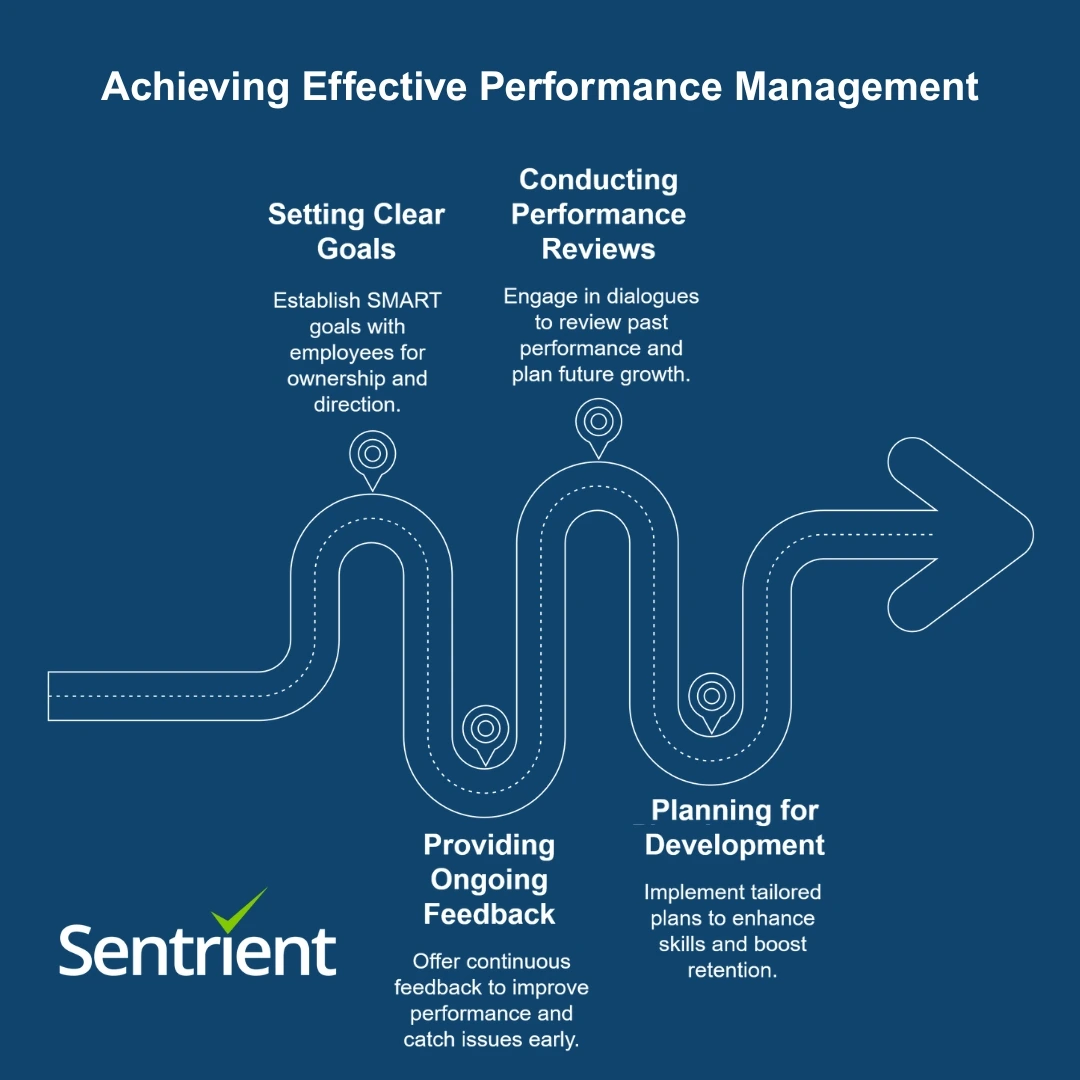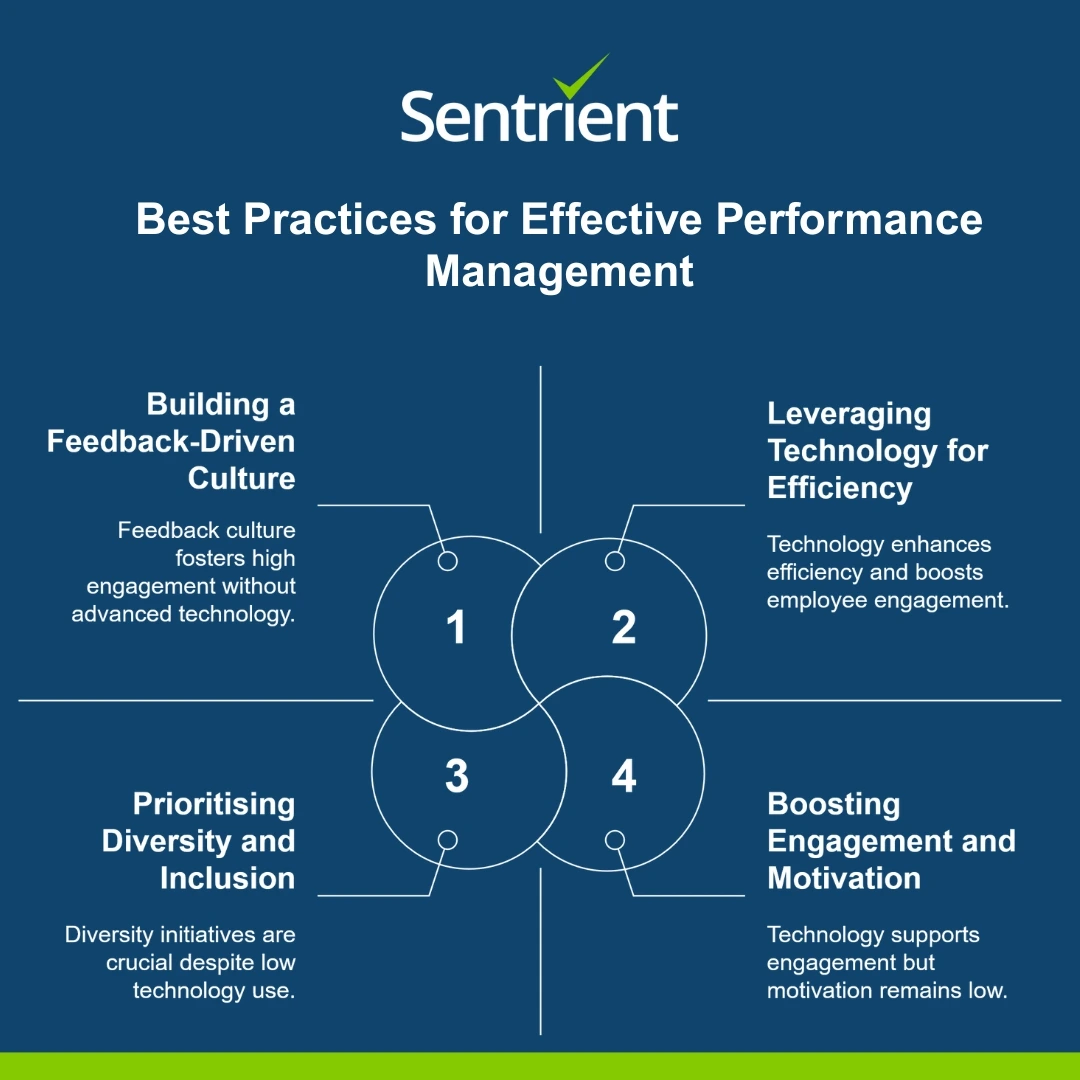Think of a workplace where every employee can thrive. Think of everyone hitting their targets, feeling valued and motivated. That’s what effective performance management practices can bring to your organisation. Despite this, countless HR managers continue to fight with outdated systems that actively hinder the business, leaving goals unmet and employees disengaged. Not many employees think that their performance reviews inspire improvement. The question remains: how do you get around that? This blog will investigate the best practices that every leader should know to transform their approach and drive results.
We’ll explore what employee performance management really means, and how it can change your businesses outlook on HR and employee management. From aligning goals and using technology, we’ll show you how to implement practical strategies. These tips will empower you to boost your employee engagement and elevate your business. Let’s get started!
What is Performance Management?
Performance management isn’t just annual employee reviews. It’s a dynamic process of continuous improvement, embedded in your business. It aligns individual efforts with the wider goals of your organisation. An employee performance management system is all about setting expectations, providing feedback, and fostering growth. Instead of focusing on criticism, modern performance management strategies prioritise collaboration and development. This allows it to act as a compass, guiding employees towards success, all the while still keeping the business on the right path.
Why It’s Evolving
Traditional methods of rigid, annual appraisals are outdated. Performance management nowadays has shifted to meet the demands of the modern corporate landscape. More frequent check-ins are shown to greatly boost employee engagement, reflecting a need for flexibility. This agile style is a must have for leaders and managers that want to look forward. The evolution of performance management helps upskill your entire workforce, rather than arbitrarily measuring employees once every year.
Why Performance Management Matters?
Boosting Employee Engagement
A strong performance management system fuels employee engagement. Regular feedback helps your team grow more invested in the success of the business. Revamping your process to focus on ongoing projects and giving live feedback and praises can greatly enhance employee satisfaction. More engaged teams are more productive and thus profitable, demonstrating how this practice benefits both HR managers and business owners alike.
Driving Organisational Success
It’s not just about happy employees; it’s about results. Performance management ties individual contributions to your company’s objectives. For instance, Google’s OKR system ensures everyone from interns to execs, works toward shared goals. This alignment sharpens focus and accelerates growth, making it a non-negotiable for competitive businesses.
Happy employees are only one part of the framework. The main focus is, of course, results. Performance management ties the individual contributions within the business to overall company objectives. This helps ensure everyone’s on the same page, from entry level hires all the way up to the senior management team. This strategic alignment keeps your teams grounded and focused on their goals, accelerating growth and keeping your business objective.
The Performance Management Process Explained

Setting Clear Goals
Start with goals that are SMART – Specific, Measurable, Achievable, Relevant, and Time-bound. Create them together with your employees to make a sense of ownership. A sample would be – a sales rep might aim to “grow client accounts by 10% in Q1 using targeted outreach.” Clear goal setting in performance management sets the stage for everything to come.
Providing Ongoing Feedback
Don’t wait a whole year to talk about your team’s performance. Continuous feedback on what they’re doing right and what they need to work on is essential. Connecting feedback to project milestones can help cut delays and improve outcomes, while regular and in-depth communication can catch issues early, letting you celebrate your wins with the effort they deserve.
Conducting Performance Reviews
Reviews should be dialogues, not monologues. They need to be conversations between the employee and the manager, and they shouldn’t just look at past performance. Look forward to how you see future growth for the employee and subsequently the business. Upskilling your employees begins with identifying gaps, and planning for the future can bring out the best in your team.
Planning for Development
Growth is embedded in the core of modern performance management. Tailored plans for specific roles can include mentorship programs, new projects, or training outcomes. A junior marketer might take a course to master analytics, improving their skills and your team’s capacity. Development programs aren’t a financial burden, but rather a gold-class retention booster.
10 Best Practices for Effective Performance Management

1. Align Individual Goals with Organisational Objectives
Everyone’s work should drive towards the company’s mission. Goals should cascade from the top down. That is to say, if your aim is to improve revenue by 20% for a given timeframe, you should consider providing managers with upselling training. This performance management metric will ensure unity and a sense of purpose across all teams. Tie goals to a “why” that resonates on a more personal level. Employees who believe in their targets will perform significantly better.
2. Foster a Culture of Continuous Feedback
Abandon the dread of an annual review and instead switch to real-time feedback. Most employees want regular feedback to minimise waste in the workplace. Embed it into the company culture. For example, a manager might say, “Your presentation nailed it, but let’s tweak the pacing next time.” This builds trust and agility.
3. Use Technology to Streamline Processes
Performance management software like Sentrient automates tracking and analytics, saving countless hours. Small businesses can use it to identify trends in their business performance. Tech makes performance management seamless for overseas or remote workers as well. Virtual goal tracking and immediate interactions make the whole experience flow smoothly.
4. Train Managers to be Effective Coaches
Managers are made, not born. Invest in their training, and they’ll pass down their skills to their teams. Workshops on active listening or effective goal setting can transform how they perceive their job. Managers with more training under their belt are shown to reduce conflict and help guide their teams to new heights. Pair new managers with mentors for hands-on coaching practice to accelerate their impact.
5. Encourage Employee Self-Assessment
Let employees weigh in on their progress. Prior to the review, ask them to assess their own wins and struggles, and how they think they’re faring so far. This can spark ownership of their flaws and successes, promoting richer discussions in the actual review that can be used to uncover previously unseen insights.
6. Implement Regular Check-Ins
Brief but targeted check-ins for your teams help structure the employee performance management process. These might be weekly or monthly for your most critical roles, and quarterly for more general teams. This creates a scheduled sense of credibility to the process, cutting back on panic and stress in the lead-up to a performance review.
7. Focus on Employee Development
Professional development opportunities should be tied to performance. Junior IT staff could shadow more senior members to see why they’re at the top. Employee development also helps create a sense of belonging to your business, drastically cutting down on turnover rates. Your team is upskilled, and your business retains more loyal employees. It’s a win-win!
8. Recognise and Reward Performance
Celebrate wins, both big and small. A quick “Great job on the client pitch!” or a bonus for hitting targets can work wonders for your team. Rewards reinforce what matters. Personalise recognition for their efforts. Some love the spotlight, while others prefer a quiet thanks. Ask your team what they value.
9. Ensure Fairness and Transparency
Bias kills trust. Use clear criteria and multiple inputs, like peer reviews or anonymous surveys, to keep it fair. You might audit scores to catch bias in performance reviews. Openness about how decisions are made builds confidence in you and the system.
10. Continuously Improve the Process
Performance management is always a continuous, ongoing process. Staff should be surveyed on a regular basis, with constant tweaks and adjustments to help smooth all operations. Staying up to date with performance management studies keeps you on your toes and ahead of the competition.
Overcoming Common Performance Management Challenges
Handling Resistance to Change:
New systems will always face resistance. Having more frequent reviews is bound to sound like a waste of time to your employees, but once training and immediate feedback shows its results, their minds will change quickly. Involve staff early, explain benefits, and ease the transition with support. Change sticks when it’s collaborative.
Reducing Bias in Evaluations:
Bias can often sneak in without managers even noticing. This should be countered with 360-degree feedback and standardised rubrics for all managers to use. Training on bias in performance reviews helps managers judge fairly.
Quick Takeaways
- Performance management aligns individual and company goals for maximum impact.
- Ongoing feedback beats annual reviews for engagement and agility.
- Tech streamlines processes, especially for remote teams.
- Train managers as coaches to unlock team potential.
- Development focus boosts retention and skills.
- Fair, transparent systems build trust and morale.
- Keep refining your approach with feedback and trends.
Conclusion
These best practices offer a comprehensive roadmap for HR managers and business owners, helping ditch antiquated methods and instead focus on lasting growth. It’s more than reviews; it’s about building a culture where employees excel and your business wins.
Ready to act? Start small: pick one aspect to practice, like regular check-ins, and test it this quarter. Gather feedback, tweak as needed, and scale accordingly. Your performance management strategy might just be the edge your organisation needs. Don’t wait until it’s too late. Your business is ready to succeed.
FAQs
1. What’s the difference between performance management and appraisals?
Performance management is an ongoing process of setting goals, giving feedback, and growing employees. Performance appraisal is just one part of the process, a periodic review of past work. Reviewing past performance helps you set a baseline for the employee, but the process of continuous improvement is what sets an employee performance management system apart.
2. How can remote teams optimise performance management?
Leverage performance management for remote teams with software like Sentrient for tracking. Clear goals and virtual coaching are key. If your employees can’t succeed by working remotely, you need to pass the feedback on during the next scheduled review.
3. What mistakes derail performance management?
Skipping continuous performance feedback, vague goals, or bias can tank it. Ignoring recognition also demotivates employees. These mistakes are common and easily avoidable by simply sticking to what works.
4. How often should I review performance?
Monthly or quarterly beats yearly. Frequent performance appraisals keep momentum and catch issues fast. Be sure to schedule these in advance as to not surprise your team.
5. What’s HR’s role in performance management?
HR crafts the system, trains managers, and links it to employee development plans. They’re the glue ensuring it works for everyone. If HR isn’t on board with the performance management system, it’s destined to fail.





